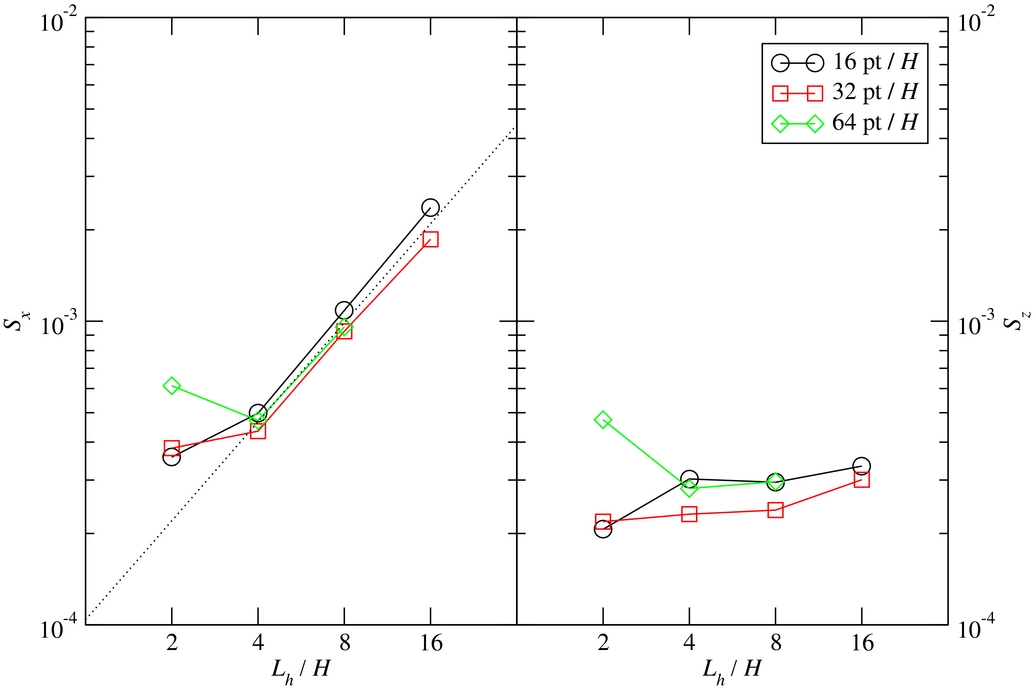
|
Chao-Chin Yang (楊朝欽)Assistant Research Professor
Department of Physics and Astronomy
University of Nevada, Las Vegas
|

|
Chao-Chin Yang (楊朝欽)Assistant Research Professor
Department of Physics and Astronomy
University of Nevada, Las Vegas
|

In this work, we studied the gravitational influence of MHD turbulence in a protoplanetary disk on the orbital dynamics of planetesimals and larger planetary objects. Because of the density perturbations in the gas, all orbital elements of an object — including orbital radius, eccentricity, and inclination — undergo random walks, resulting in increasing probability of the object deviating from its initial orbit with time. We conducted high-resolution MHD simulations with numerous planetary objects and obtained statistically accurate measurements of this effect. These measurements provide a prescription for modelling the dynamical/collisional evolution of planetesimals in a young protoplanetary disk. The figure shows the strengths of this effect on the radial (x) and the vertical (z) components of the velocity dispersion of an ensemble of planetesimals, as a function of the horizontal size of the simulation box (Lh).
References:
Yang, C.-C., Mac Low, M.-M., & Menou, K. 2009, ApJ, 707,
1233.
Yang, C.-C., Mac Low, M.-M., & Menou, K. 2012, ApJ, 748,
79.
Protoplanetary disks are often modeled by a 1D viscous evolutionary equation based on Lynden-Bell & Pringle (1974). However, we note that this equation involves two important assumptions that may be violated when the disk contains any small-scale structures. These assumptions are that the disk rotate at nearly Keplerian frequency at all radii and that the rotation profile be independent of time. A small-scale structure can generate appreciable radial pressure gradient that modifies the rotation profile. If a local pressure gradient becomes too steep, the disk at this location can become unstable, leading to turbulence which diffuses the small-scale structure and returns the system back to stability. This process cannot be captured by the 1D viscous equation.
Therefore, we caution that the stability criterion needs to be explicitly checked whenever the 1D viscous evolution is considered. Whenever an instability is detected, we propose to use a diffusion equation to adjust the density profile such that the stability is recovered. The figure shows such a procedure on two profiles (solid lines) that are unstable and demonstrates that the same profile with marginal stability (dashed lines) is recovered by the diffusion equation irrespective of the diffusion coefficient used.
Reference: Yang, C.-C., Menou, K. 2010, MNRAS, 402, 2436.
Realized by the back reaction of the solid particles (pebbles/dust) to the gas drag, the streaming instability tends to drive axisymmetric filamentary structures in the dust component of a protoplanetary disk. In order to characterize the properties of these structures, we conducted computer simulations of this process in a laminar disk with the largest domain to date. The figure shows the top-down (radial-azimuthal) view of the solids in the disk in the nonlinear stage of the streaming instability. Multiple axisymmetric filaments (up to five in the figure) are simultaneously concentrated by the instability and coexist in the disk. A systematic study of the computational domain helped us obtain a convergent measurement of the properties of the filaments, most importantly the characteristic radial separation between adjacent filaments.
This work has several important implications in protoplanetary disks and planet formation. First, it demonstrated that an axisymmetric structure in the dust component of a protoplanetary disk can be readily driven by the dust particles themselves via the back reaction force to the gas, without the presence of any planetary object. Second, the well-defined characteristic separation implies a characteristic mass budget for the formation of planetesimals. It turned out that indeed the characteristic mass of newborn planetesimals correlates well with the mass budget of each filement. Finally, any chemical inhomogeneity down to this scale may have an imprint in the compositions of asteroids and Kuiper Belt objects in the Solar System.
References:
Yang, C.-C., & Johansen, A. 2014, ApJ, 792,
86.
Schäfer, U., Yang, C.-C., & Johansen, A. 2017, A&A, 597,
A69.
Movie: top (radial-azimuthal) view of the disk solids, before gravitational collapse
In the studies of substructures of dust component in protoplanetary disks shaped by an embedded planet, i.e., spirals, gaps and rings, and lop-sided concentration, dust back reaction to the gas was often neglected. To evaluate how dust back reaction would change the morphology of the disk, therefore, we used computer simulations and systematically varied the dust size, the solid abundance, and the planetary mass.
We found that dust back reaction indeed affects the substructures driven by a planet. When the dust particles are small, the spirals become less open and the gap becomes deeper with increasing back reaction. When the dust particles are large, on the other hand, the gap structure can be significantly skewed. Finally, a large-scale vortex induced by a massive planet can be broken into numerous small-scale dust-gas vortices.
Referencs: Yang, C.-C., & Zhu, Z. 2020, MNRAS, 491, 4702.